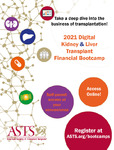Applicability, safety, and biological activity of regulatory T cell therapy in liver transplantation
| dc.contributor.author | Sánchez‐Fueyo, A | |
| dc.contributor.author | Whitehouse, G | |
| dc.contributor.author | Grageda, N | |
| dc.contributor.author | Cramp, Matthew | |
| dc.contributor.author | Lim, TY | |
| dc.contributor.author | Romano, M | |
| dc.contributor.author | Thirkell, S | |
| dc.contributor.author | Lowe, K | |
| dc.contributor.author | Fry, L | |
| dc.contributor.author | Heward, J | |
| dc.contributor.author | Kerr, A | |
| dc.contributor.author | Ali, J | |
| dc.contributor.author | Fisher, C | |
| dc.contributor.author | Lewis, G | |
| dc.contributor.author | Hope, A | |
| dc.contributor.author | Kodela, E | |
| dc.contributor.author | Lyne, M | |
| dc.contributor.author | Farzaneh, F | |
| dc.contributor.author | Kordasti, S | |
| dc.contributor.author | Rebollo‐Mesa, I | |
| dc.contributor.author | Jose Lozano, J | |
| dc.contributor.author | Safinia, N | |
| dc.contributor.author | Heaton, N | |
| dc.contributor.author | Lechler, R | |
| dc.contributor.author | Martínez‐Llordella, M | |
| dc.contributor.author | Lombardi, G | |
| dc.date.accessioned | 2021-09-20T09:51:04Z | |
| dc.date.issued | 2020-04 | |
| dc.identifier.issn | 1600-6135 | |
| dc.identifier.issn | 1600-6143 | |
| dc.identifier.uri | http://hdl.handle.net/10026.1/17837 | |
| dc.description.abstract |
Regulatory T cells (Tregs) are a lymphocyte subset with intrinsic immunosuppressive properties that can be expanded in large numbers ex vivo and have been shown to prevent allograft rejection and promote tolerance in animal models. To investigate the safety, applicability, and biological activity of autologous Treg adoptive transfer in humans, we conducted an open-label, dose-escalation, Phase I clinical trial in liver transplantation. Patients were enrolled while awaiting liver transplantation or 6-12 months posttransplant. Circulating Tregs were isolated from blood or leukapheresis, expanded under good manufacturing practices (GMP) conditions, and administered intravenously at either 0.5-1 million Tregs/kg or 3-4.5 million Tregs/kg. The primary endpoint was the rate of dose- limiting toxicities occurring within 4 weeks of infusion. The applicability of the clinical protocol was poor unless patient recruitment was deferred until 6-12 months posttransplant. Thus, only 3 of the 17 patients who consented while awaiting liver transplantation were dosed. In contrast, all six patients who consented 6-12 months posttransplant received the cell infusion. Treg transfer was safe, transiently increased the pool of circulating Tregs and reduced anti-donor T cell responses. Our study opens the door to employing Treg immunotherapy to facilitate the reduction or complete discontinuation of immunosuppression following liver transplantation. | |
| dc.format.extent | 1125-1136 | |
| dc.format.medium | Print-Electronic | |
| dc.language | en | |
| dc.language.iso | en | |
| dc.publisher | Wiley | |
| dc.subject | cellular transplantation (nonislet) | |
| dc.subject | immunosuppression | |
| dc.subject | immune modulation | |
| dc.subject | liver transplantation | |
| dc.subject | hepatology | |
| dc.subject | T cell biology | |
| dc.subject | tolerance | |
| dc.subject | translational research | |
| dc.subject | science | |
| dc.title | Applicability, safety, and biological activity of regulatory T cell therapy in liver transplantation | |
| dc.type | journal-article | |
| dc.type | Clinical Trial, Phase I | |
| dc.type | Journal Article | |
| dc.type | Research Support, Non-U.S. Gov't | |
| plymouth.author-url | https://www.webofscience.com/api/gateway?GWVersion=2&SrcApp=PARTNER_APP&SrcAuth=LinksAMR&KeyUT=WOS:000510520500001&DestLinkType=FullRecord&DestApp=ALL_WOS&UsrCustomerID=11bb513d99f797142bcfeffcc58ea008 | |
| plymouth.issue | 4 | |
| plymouth.volume | 20 | |
| plymouth.publication-status | Published | |
| plymouth.journal | American Journal of Transplantation | |
| dc.identifier.doi | 10.1111/ajt.15700 | |
| plymouth.organisational-group | /Plymouth | |
| plymouth.organisational-group | /Plymouth/Faculty of Health | |
| plymouth.organisational-group | /Plymouth/Faculty of Health/Peninsula Medical School | |
| plymouth.organisational-group | /Plymouth/REF 2021 Researchers by UoA | |
| plymouth.organisational-group | /Plymouth/REF 2021 Researchers by UoA/UoA01 Clinical Medicine | |
| plymouth.organisational-group | /Plymouth/Research Groups | |
| plymouth.organisational-group | /Plymouth/Research Groups/Institute of Translational and Stratified Medicine (ITSMED) | |
| plymouth.organisational-group | /Plymouth/Research Groups/Institute of Translational and Stratified Medicine (ITSMED)/CBR | |
| plymouth.organisational-group | /Plymouth/Users by role | |
| plymouth.organisational-group | /Plymouth/Users by role/Academics | |
| dc.publisher.place | United States | |
| dcterms.dateAccepted | 2019-11-04 | |
| dc.rights.embargodate | 2021-9-21 | |
| dc.identifier.eissn | 1600-6143 | |
| dc.rights.embargoperiod | Not known | |
| rioxxterms.versionofrecord | 10.1111/ajt.15700 | |
| rioxxterms.licenseref.uri | http://www.rioxx.net/licenses/all-rights-reserved | |
| rioxxterms.licenseref.startdate | 2020-04 | |
| rioxxterms.type | Journal Article/Review |


